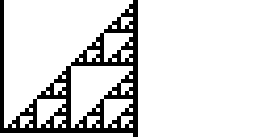Rule 102 is one of the elementary cellular automaton rules introduced by Stephen Wolfram in 1983 (Wolfram 1983, 2002). It
specifies the next color in a cell, depending on its color and its immediate neighbors.
Its rule outcomes are encoded in the binary representation
. This rule is illustrated
above together with the evolution of a single black cell it produces after 15 steps
(OEIS A075439; Wolfram 2002, p. 55).
Starting with a single black cell, successive generations are given by interpreting the numbers 1, 6, 20, 120, 272, 1632, 5440, 32640, ... (OEIS A117998)
in binary. Omitting trailing zeros (the right cells in step
of the triangle are always 0) gives 1, 3, 5, 15, 17, 51, 85,
255, 257, 771, ... (OEIS A001317), which are
simply the previous numbers divided by
and which have binary representation 1, 11; 101, 1111, 10001,
... (OEIS A047999). Surprisingly, this is precisely
the Sierpiński sieve.
The mirror image is rule 60, the complement is rule 153, and the mirrored complement is rule 195.

Rule 102 is one of the eight additive elementary cellular automata (Wolfram 2002, p. 953).